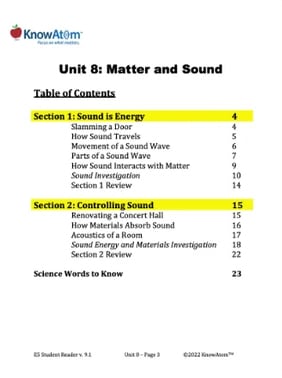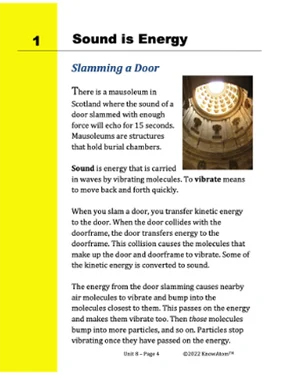Science background provides teachers with more detailed information about the phenomena students explore in this unit. Here is an excerpt from the science background information on sound energy.
Jordan Hall has been around for more than 100 years, and it is the only conservatory building in the United States to be designated a National Historic Landmark. The New England Conservatory calls the concert hall “acoustically suburb.” Acoustics refers to the properties of a space that determine how sound waves travel. The acoustics of a space are important when designing buildings such as auditoriums, theaters, and libraries.
Concert halls like Jordan Hall are often designed with many curves that move the sound around the room so that everyone in the room can hear the music. Concert halls also have carpet to absorb sound, transferring the sound energy into heat and preventing echoes.
Because of Jordan Hall’s acoustics, the 1995 renovation was done with extreme caution. Laurence Lesser, a cellist and president of the New England Conservancy, was determined that no structural changes be made that would interfere with the hall’s renowned acoustics.
However, the night after the renovations were complete, the sound was different enough that some audience members covered their ears with their hands. It turned out that the new paint wasn’t as porous as the old paint. Porosity refers to the amount of space between particles in a substance, so the new paint didn’t have a lot of spaces between its particles.
It’s possible the new paint was much more reflective than the old paint, so it absorbed less sound. To reflect means to bounce off of something. To absorb means to take in. To transmit means to pass onward. When more of the sounds were absorbed in the hall, the music had a softer sound. With the new paint reflecting more of the sound, the music gained a “brighter” sound that many people disliked. After a year, the concert hall added felt material to its walls. This restored the acoustics in the hall because the felt was more absorbent than the reflective paint.
To understand how felt and different kinds of paint can affect sound, it’s important to first understand the basics of sound. Sound is energy that is carried in waves by vibrating molecules. To vibrate means to move back and forth quickly. Because it involves moving molecules, sound is a form of kinetic energy.
Sound waves are these patterns of vibrating molecules caused by the movement of sound through a medium. Sound has to travel through some kind of matter because it can only move when vibrating molecules collide with one another and transmit the energy. Because of this, sound can travel through solids, liquids, or gasses. Air is a gas medium. Water is a liquid medium. Brick and wood are both solid mediums.
It is important to note that waves don’t carry matter. Molecules stop vibrating and return to their original position once they have passed on the energy.
As a sound wave moves through matter, it causes molecules to press together. This is called compression. When this happens, the molecules on either side of the compression spread out. This is called rarefaction.










